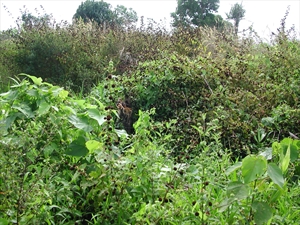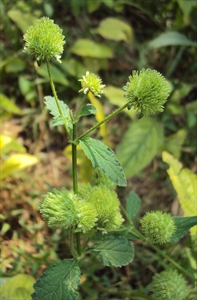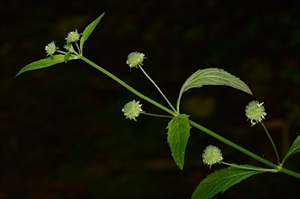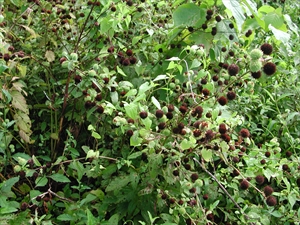Knobweed. It is also known as false ironwort, wild-hops.
Pacific Pests, Pathogens, Weeds & Pesticides - Online edition
Pacific Pests, Pathogens, Weeds & Pesticides
Knobweed (497)
Hyptis capitata; previously, it was known as Hyptis rhomboidea. It is a member of the Lamiaceae.
Asia, North (Hawaii, Mexico), South and Central America, the Caribbean, Oceania. It is recorded from Australia, Federated States of Micronesia, French Polynesia, Guam, Palau, Samoa, and Solomon Islands. It is a native of Central and South America and the Caribbean.
A weed of disturbed unshaded areas with moist heavy soils. Dense thickets form in fallowed gardens (shifting cultivation), overgrazed pastures, roadsides, wastelands, and on the banks of streams. Also, found in open forests, forest margins and clearings. Germination of the seeds requires exposure to light. Unpalatable to livestock. Grows up to 750 masl.
Upright herbaceous plant, 50-250 cm tall, with branching square stems becoming woody with age, forming dense thickets (Photo 1). Leaves, opposite along the stems, widely spaced, with serrated margins, and a minty smell when crushed, from oil glands on the underside. Flowers, white, borne in small, dense, round clusters (15-25 mm across) at the top of flower stalks (peduncles), 2-9 cm long, produced in the upper leaf axils (Photo 2). Individual flowers, minute, tubular, and surrounded by a green tube-like structure (calyx), 3-4 mm long, which enlarges, up to 10 mm (Photo 3). The round clusters of flowers turn brown when mature, with each fruit dividing into four parts, the 'seeds' (Photo 4). The seeds rattle when the stems are shaken.
Note, a close relative, hyptis (Hyptis suaveolens), is similar. It has pinkish, bluish-purple or lavender coloured flowers that are borne in loose few-flowered clusters in the leaf forks (axils). Lesser roundweed (Hyptis brevipes), is also similar in appearance to knobweed, but has smaller flower-heads, up to 14 mm diameter, and shorter flower stalks, up to 1.5 cm.
Seeds (still in the fruit) in water, and by attachment to the fur of animals, clothes of humans, and mud on machinery and vehicles. Long distance spread can occur as a contaminant of seed.
In Australia, impacts both environmental and economic. In open eucalypt forests and rainforests knobweed replaces native species; it is also important in pastures, especially those degraded by being overgrazed or with poor nutrition. Knobweed can resprout or recover faster than pasture species and gradually takes over. Once established, slashing and mowing becomes ineffective, and its large seed production help it outcompete other species. It has become an important weed in Samoa.
Said to have medicinal uses: leaves uses as a sedative to reduce heart palpitations, to clean wounds, and for stomach ache.
BIOSECURITY
The chances of introduction of knobweed is high. Countries not yet infested should consider all likely pathways for entry, and apply quarantine measures accordingly. Particular attention should be given to contamination of seed lots, particularly, pasture species.
BIOLOGICAL CONTROL
Not a method recommended for Hyptis capitata.
CULTURAL CONTROL
- Physical & Mechanical:
- Hand-pulling (or grubbing) is possible for small infestations, preferably before flowering. Make sure to remove the base of the stem and top of the roots (crown) to avoid resprouting. Burn plants on site.
- Slash infestations, preferably before flowering. Make sure to remove rootstocks as above, or monitor and treat regrowth with herbicide. Apply fertiiser to promote rapid growth of pasture species; or, if pasture is poor, reseed.
- Hygiene:
- Treat vehicles and farm machinery. If moving from areas where the weed occurs to those weed-free, wash to remove soil. This is equally important if the machinery is being imported into a country or moved within a country.
CHEMICAL CONTROL
2,4-D amine and glyphosate are recommended in Australia.
--------------------
Note, EU approval to use glyphosate ends in December 2022; ; its use after that date is under discussion.
____________________
When using a pesticide, always wear protective clothing and follow the instructions on the product label, such as dosage, timing of application, and pre-harvest interval. Recommendations will vary with the crop and system of cultivation. Expert advice on the most appropriate herbicides to use should always be sought from local agricultural authorities.
AUTHOR Grahame Jackson
Information from PIER (2013) Hyptis capitata Jacq., Lamiaceae. Pacific Island Ecosystems at Risk (PIER), Institute of Pacific Islands Forestry. (http://www.hear.org/pier/species/hyptis_capitata.htm); and CABI (2019) Hyptis suaveolens (pignut). Invasive Species Compendium. (https://www.cabi.org/isc/datasheet/110258); and DAF (2020) Knobweed Hyptis capitatia. Queensland Government. (https://www.daf.qld.gov.au/__data/assets/pdf_file/0020/77213/knobweed.pdf); and Conran J (2021) Hyptis capitata Jacq. Knobweed. WeedsAustralia - Profiles. Centre for Invasive Species Solutions, Department of Agriculture, Weeds and the Environment. Australian Government. (https://profiles.ala.org.au/opus/weeds-australia/profile/Hyptis%20capitata); and from Ken Fern (2019) Hyptis capitata. Useful tropical plants. (http://tropical.theferns.info/viewtropical.php?id=Hyptis+capitata). Photo 3 Vinayaraj Hyptis capitata. (https://commons.wikimedia.org/wiki/File:Hyptis_capitata_07.JPG). Photo 4 M Fagg, Australian Plant Image Index (https://www.anbg.gov.au/cgi-bin/phtml?pc=dig&pn=48904&size=3).
Produced with support from the Australian Centre for International Agricultural Research under project HORT/2016/185: Responding to emerging pest and disease threats to horticulture in the Pacific islands, implemented by the University of Queensland and the Secretariat of the Pacific Community.







